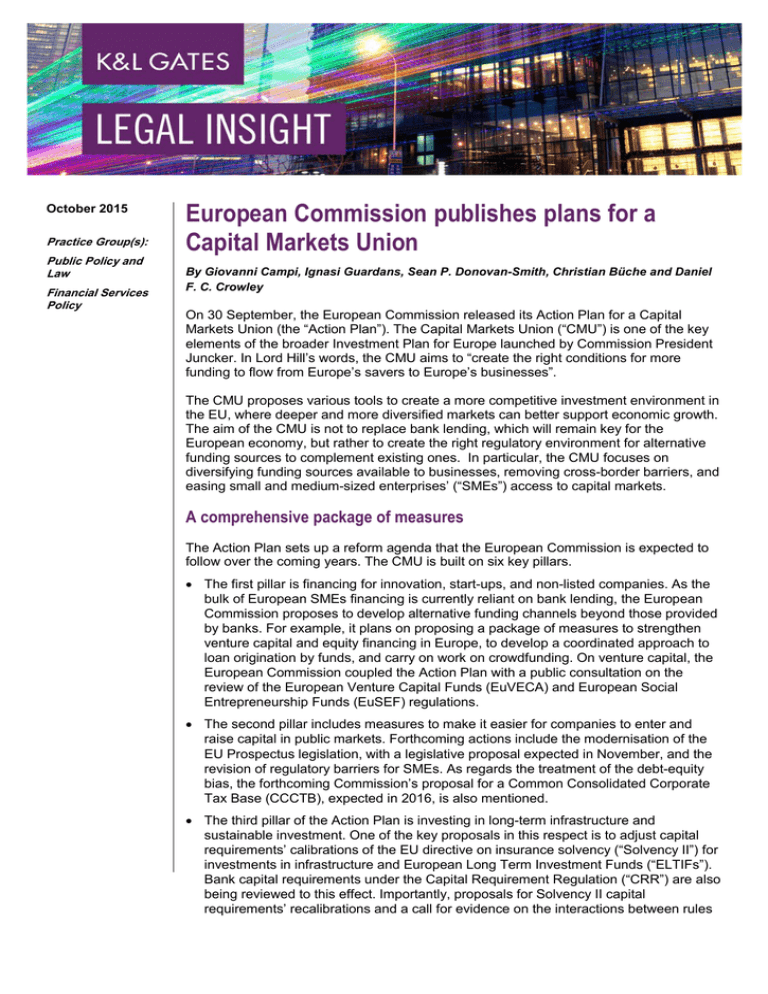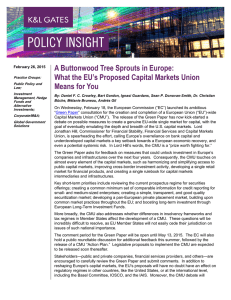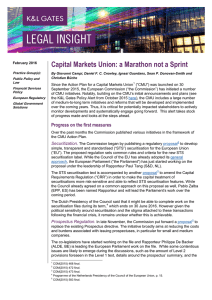European Commission publishes plans for a Capital Markets Union
advertisement

October 2015 Practice Group(s): Public Policy and Law Financial Services Policy European Commission publishes plans for a Capital Markets Union By Giovanni Campi, Ignasi Guardans, Sean P. Donovan-Smith, Christian Büche and Daniel F. C. Crowley On 30 September, the European Commission released its Action Plan for a Capital Markets Union (the “Action Plan”). The Capital Markets Union (“CMU”) is one of the key elements of the broader Investment Plan for Europe launched by Commission President Juncker. In Lord Hill’s words, the CMU aims to “create the right conditions for more funding to flow from Europe’s savers to Europe’s businesses”. The CMU proposes various tools to create a more competitive investment environment in the EU, where deeper and more diversified markets can better support economic growth. The aim of the CMU is not to replace bank lending, which will remain key for the European economy, but rather to create the right regulatory environment for alternative funding sources to complement existing ones. In particular, the CMU focuses on diversifying funding sources available to businesses, removing cross-border barriers, and easing small and medium-sized enterprises’ (“SMEs”) access to capital markets. A comprehensive package of measures The Action Plan sets up a reform agenda that the European Commission is expected to follow over the coming years. The CMU is built on six key pillars. • The first pillar is financing for innovation, start-ups, and non-listed companies. As the bulk of European SMEs financing is currently reliant on bank lending, the European Commission proposes to develop alternative funding channels beyond those provided by banks. For example, it plans on proposing a package of measures to strengthen venture capital and equity financing in Europe, to develop a coordinated approach to loan origination by funds, and carry on work on crowdfunding. On venture capital, the European Commission coupled the Action Plan with a public consultation on the review of the European Venture Capital Funds (EuVECA) and European Social Entrepreneurship Funds (EuSEF) regulations. • The second pillar includes measures to make it easier for companies to enter and raise capital in public markets. Forthcoming actions include the modernisation of the EU Prospectus legislation, with a legislative proposal expected in November, and the revision of regulatory barriers for SMEs. As regards the treatment of the debt-equity bias, the forthcoming Commission’s proposal for a Common Consolidated Corporate Tax Base (CCCTB), expected in 2016, is also mentioned. • The third pillar of the Action Plan is investing in long-term infrastructure and sustainable investment. One of the key proposals in this respect is to adjust capital requirements’ calibrations of the EU directive on insurance solvency (“Solvency II”) for investments in infrastructure and European Long Term Investment Funds (“ELTIFs”). Bank capital requirements under the Capital Requirement Regulation (“CRR”) are also being reviewed to this effect. Importantly, proposals for Solvency II capital requirements’ recalibrations and a call for evidence on the interactions between rules European Commission publishes plans for a Capital Markets Union and cumulative impact of the financial reform were also launched as part of the Action Plan. • Actions to foster retail and institutional investment constitute the fourth pillar of the Action Plan. The European Commission considers retail savings as key to unlocking capital markets. The aim is to increase consumer choice and to develop cross-border competition on retail financial services and insurance. Key initiatives in this respect are the launch of a Green Paper on retail financial services and insurance later this year, as well as the identification of barriers to the cross-border distribution of investment funds. • The fifth pillar is the ability to leverage banking capacity to support the wider economy. One of the first projects within the CMU is a new legislative proposal on simple, transparent, and standardised (STS) European securisation, presented together with the Action Plan. A consultation on an EU-wide framework for covered bonds has also been launched. The European Commission also plans to explore the possibility for all Member States to authorise credit unions outside the scope of European capital requirements’ rules for banks. • Finally, the sixth pillar deals with facilitating cross-border investment. Taking into account that the European Commission aims to create a genuinely single capital market, this pillar includes a number of long-term initiatives, including actions to remove cross-border tax barriers, foster convergence of business insolvency proceedings, and improve the market infrastructure for cross-border investments. The Action Plan also announces the publication of a White Paper on the funding and governance of the European Supervisory Authorities in the first half of 2016. The CMU is a long-term, incremental project. Considering its large scope and the more than 30 reforms and actions proposed, swift policymaking and effective implementation will be key to meet the European Commission’s ambitious timeline. Does it matter for businesses? The launch of the CMU reflects the European Commission’s priority to develop a more investment-friendly environment in the EU. If the CMU fulfils its promises in the mediumto long term, and measures are implemented timely and consistently, it can be expected that businesses - not only from the EU but from all over the world - will benefit from easier and more diversified access to capital and from enhanced cross-border capital flows within the EU. Progress in building the CMU will be thoroughly scrutinised in the years to come in order to identify areas for improvement, in particular since the Action Plan announced many proposals, reviews and studies over the coming years. This process, made up of various policy streams, will include many opportunities for stakeholders to voice their opinions, concerns and expectations to the legislators, and to provide evidence and expertise as appropriate. Timely, granular stakeholder input, starting with the public consultations on venture capital and covered bonds launched today by the European Commission, will be key to steer the policymaking process and design rules that are balanced and fit for purpose. The CMU also requires the full involvement and commitment of the EU member states to make things happen. Linked to this, there is a complex set of regulatory, cultural, and behavioural obstacles to overcome: businesses’ role and input will be key to push the project forward and to ensure that it fulfils its key objectives. 2 European Commission publishes plans for a Capital Markets Union Finally, the CMU must be viewed in the context of global policy responses to the credit crises on both sides of the Atlantic. At a time when the Financial Stability Board and the U.S. Financial Stability Oversight Council continue to take steps to shore up bank financing and expand macroprudential regulation to non-banks, the European Commission has recognized the need to expand non-bank financing. Interestingly, Commissioner Hill has indicated that U.S. capital markets are a model to be referenced while creating the CMU. It remains to be seen whether capital markets can flourish in an environment in which a safety and soundness regulatory paradigm dominates, and to what extent financial services providers located outside the EU will be welcome. Alternatively, U.S. regulators could be compelled to rethink the application of bank-like regulation to capital markets participants. In other words, there are regulatory and competitive implications of the CMU on both sides of the Atlantic. Links to documents issued by the European Commission today Action Plan for a Capital Markets Union (CMU) and accompanying economic analysis Securitisation initiative comprising of i) a proposal for simple, transparent and standardised (STS) securitisation, and ii) a proposal to amend the Capital Requirements Regulation to make the capital treatment of securitisations for banks and investment firms more risk-sensitive and able to reflect the specific features of STS securitisations Proposals to amend the Solvency II delegated act concerning the calculation of regulatory capital requirements for several categories of assets held by insurance and reinsurance undertakings, in particular with regard to infrastructure investments and ELTIFs Public consultation on the review of the European Venture Capital Funds (EuVECA) and European Social Entrepreneurship Funds (EuSEF) regulations Public consultation on covered bonds in the European Union Call for evidence on the EU regulatory framework for financial services Authors: Giovanni Campi giovanni.campi@klgates.com +32.(0)2.336.1910 Ignasi Guardans ignasi.guardans@klgates.com +32.(0)2.336.1949 Sean P. Donovan-Smith sean.donovan-smith@klgates.com +44.(0)20.7360.8202 Christian Büche christian.bueche@klgates.com +49.(0)69.945.196.365 Daniel F. C. Crowley dan.crowley@klgates.com +1.(202) 778-9447 3 European Commission publishes plans for a Capital Markets Union Anchorage Austin Beijing Berlin Boston Brisbane Brussels Charleston Charlotte Chicago Dallas Doha Dubai Fort Worth Frankfurt Harrisburg Hong Kong Houston London Los Angeles Melbourne Miami Milan Moscow Newark New York Orange County Palo Alto Paris Perth Pittsburgh Portland Raleigh Research Triangle Park San Francisco São Paulo Seattle Seoul Shanghai Singapore Spokane Sydney Taipei Tokyo Warsaw Washington, D.C. Wilmington K&L Gates comprises more than 2,000 lawyers globally who practice in fully integrated offices located on five continents. The firm represents leading multinational corporations, growth and middle-market companies, capital markets participants and entrepreneurs in every major industry group as well as public sector entities, educational institutions, philanthropic organizations and individuals. For more information about K&L Gates or its locations, practices and registrations, visit www.klgates.com. This publication is for informational purposes and does not contain or convey legal advice. The information herein should not be used or relied upon in regard to any particular facts or circumstances without first consulting a lawyer. © 2015 K&L Gates LLP. All Rights Reserved. 4







